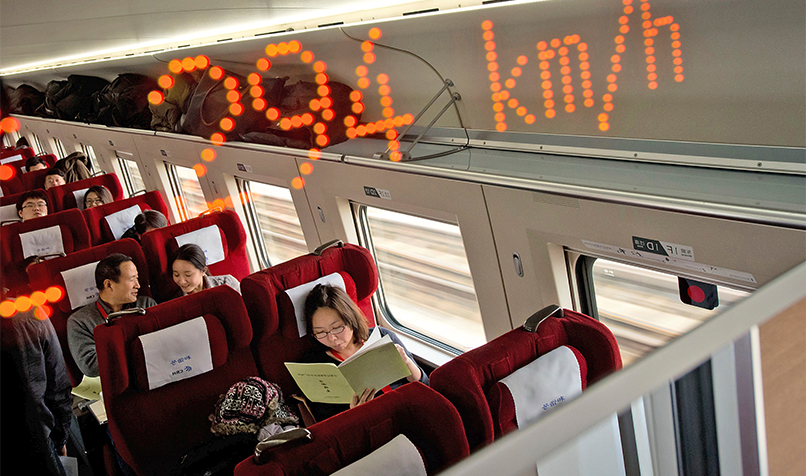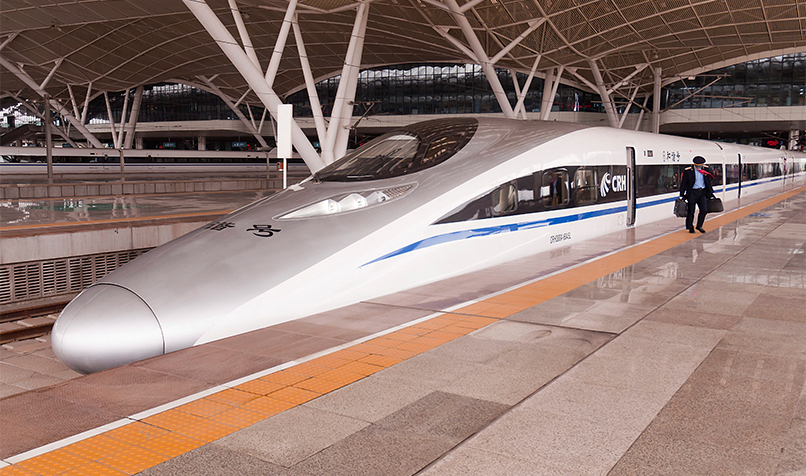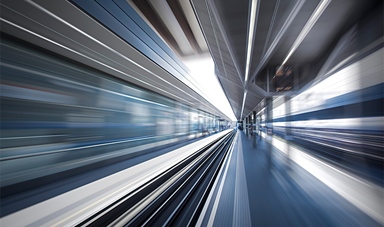Loading component...
At a glance
Updated 19 August 2016
When the first Shinkansen bullet train shot out of Tokyo station more than 50 years ago, it carried not only passengers but also the ambitions of an entire nation.
The high-speed Tokaido line train cut the trip between the populous capital and the commercial centre of Osaka by three hours and remains the gold standard of transport efficiency today.
Within one decade, the line generated enough income to cover its development and running costs.
More than 5.6 billion passengers have safely travelled the line at speeds that reach 320 km/h, and it has saved them an estimated 400 million hours in travel a year.
Around the world, this need for speed was quick to catch on.
One nation’s commitment to high-speed rail (HSR) has surpassed even Japan’s. China has laid at least 16,000km of HSR tracks in the past 15 years and its Shanghai Maglev train hits speeds of 430 km/h.
Yet the high-speed success of Japan and China has been tougher to repeat elsewhere.
While the benefits of HSR are promoted with great enthusiasm, many projects experience significant problems down the line.
Today, HSR carves a network across Europe – but only the line connecting Paris and Lyon sees a profit and its margins are being increasingly squeezed by competition from low-cost airlines.
High-speed rail projects have spread to the US – yet while ground has been broken on an HSR project in California, it faces ballooning costs.
Saudi Arabia and Morocco have also commenced HSR construction, and Indonesia is considering HSR between Jakarta, Bandung and Surabaya, but plans for the HSR connecting Singapore and Malaysia have recently stalled.
HSR: A heavy load to carry
Highly competitive with air travel for distances between 200 and 900km, HSR can connect city centres without the inconvenience of airport delays.
It can improve accessibility for freight transport, a cornerstone of Germany’s HSR strategy. It can reduce passenger and traffic congestion.
It can also cause economic chaos.

Cost will always be the greatest challenge for HSR. As with so many megaprojects, overruns are rife.
In 2009, the California High Speed Rail Authority put the cost of its HSR from Los Angeles to San Francisco at US$42.6 billion and today the figure has grown by almost 60 per cent.
With HSR projects usually funded from the public purse, that inevitably turns attention to the other social benefits such a huge amount of money could buy.
The enormous financial risks associated with this cost reduce the appeal of public-private partnerships (PPPs) for these projects, and those PPPs that are formed tend to unravel.
Italy’s first HSR was originally structured as a PPP, but was later nationalised due to a shortage of additional private investment. Taiwan’s HSR, opened for service in 2007, cost about US$16.5 billion and was one of the world’s largest build-operate-and-transfer models.
Depreciation charges, interest burdens and lower-than-expected demand have led to heavy losses and lawsuits.
David Hensher, director of the University of Sydney’s Institute of Transport and Logistics Studies, says the real benefits of HSR projects are likely to be experienced over a far longer, and broader, horizon than is normally considered in government evaluations.
“It comes down to the government’s obligation and commitment to the social value because from a commercial point of view, these things are pretty marginal,” says Hensher.
“The return on private investment is likely to be through the patronage and any tax advantage they can have on the capital. To be honest, it’s not great.”
There’s a “sweet spot” for HSR success, according to David Walker, associate director of KPMG’s Infrastructure and Project Group, who was also involved in a 2013 feasibility study into HSR in Australia.
“The sweet spot is where there’s a journey duration of less than three hours and greater than two,” he says.
“You need major cities a bit over 150km away from each other so that people want to use HSR, but not too far apart that the journey time becomes arduous. It comes down to geographics and population density. It’s going to work very well in some countries and not so well in other countries.”
Finding the numbers
Predicting traffic demand is a difficult task in the appraisal of any infrastructure project, let alone one the size of HSR. Yet high demand is usually a precondition for a positive contribution to the economy.
The European Commission states that only under exceptional circumstances should a new HSR line be justified with an annual level of patronage below 6 million passengers in the opening year.
With typical construction costs and time savings, the Commission puts the minimal viable number at 9 million passengers per year.
Japan’s Tokaido line soon dwarfed this figure. Similarly, the Train à Grande Vitesse’s (TGV’s) Paris-Lyon line in France had carried 14 million passengers within its first full year of operation.
Between 1981 and 1984, air traffic as a share of the journeys made on this route dropped from 31 per cent to 7 per cent while the share of HSR travel increased from 40 per cent to 72 per cent.
While the competitive landscape has changed since then, the line remains profitable.
Traffic volumes in China also look promising. So too does the cost.
While the infrastructure unit price of HSR in Europe is US$25-39 million per kilometre and the current estimated cost for California is US$56 million per kilometre, China’s figure comes in at US$17-21 million.
China boom for HSR
A 2014 World Bank paper indicates China’s HSR traffic grew from 128 million trips in 2008 to 672 million trips in 2013. By now, the system has provided well over 3 billion trips.
China’s network has “promising initial traffic”, the World Bank states, but it has reserved judgment about whether China’s HSR ultimately makes social and financial sense.
Daniel Albalate, a professor in the department of economic policy at the University of Barcelona and co-author of The Economics and Politics of High Speed Rail (Lexington Books, Lanham, MD, 2013), acknowledges that the HSR network is increasing at an impressive rate in China. He also notes its accessibility issues.
There is a pronounced difference in fares: HSR fares usually cost between seven and 10 cents per kilometre per person in China, compared to two or three cents for traditional intercity rail.
“HSR prices are much higher than prior prices of railway services and we know that the arrival of HSR is usually linked to the dismantling of conventional lines,” Albalate argues.
“Those users that today are not willing to pay the new price are now worse off travelling by bus.”
A promise to the regions
High-speed rail projects often run into trouble when they’re sold on a promise of promoting regional equity and fostering regional development. Evidence suggests the opposite is true.
The Shinkansen network delivers much of Japan’s workforce to Tokyo. When the Paris to Rhone-Alps line was introduced to France’s TGV network, train travel increased to Paris by 144 per cent, while travel in the opposite direction grew by only 54 per cent.

Albalate says claims of regional development and prosperity create a false demand for HSR and that large and dynamic nodes tend to attract economic activity that was previously located at poorer and smaller ones.
“Once the demand is there, politicians are trapped by their own statements and it becomes a political objective beyond a transportation objective,” he says.
“In any case, we see governments claiming that high-speed rail is providing both economic development and regional convergence and this serves to extend networks by adding lines with few potential traffic figures. That is why extending lines under this approach usually leads to economic failure of a project."
High-speed rail is an obvious concern for an economist living in Spain. Expansion of the country’s network was sought with great intensity during a time of economic crisis.
The first HSR route began between Madrid and Seville in 1992 and the size of the network is surpassed only by China’s. Yet its traffic falls short of the volumes in Japan, France and Germany.
"Transport policy in Spain has nothing to do with mobility,” declares Albalate, adding that: “In HSR, the objective was to connect Madrid to all the provincial capitals to reinforce the economic and political weight of the political capital.”
Spain’s network cost an estimated €40 billion to build and receives significant annual subsidies.
“The opportunity cost of this ambitious rail network has been huge for the Spanish people,” says Albalate, expressing surprise at government claims of positive HSR impacts around the world.
“Do not get impressed by how modern HSR apparently is,” he cautions. “Make a reasonable cost benefit analysis. And do not worry: I’m sure teletransportation will be invented very soon.”
Why no fast trains for Australia?
Australians have debated high-speed rail for decades. In 2013, the then transport minister, Anthony Albanese, released the second phase of a A$20 million feasibility study into a 1748km HSR network connecting Brisbane, Sydney, Canberra and Melbourne.
That study estimated costs at A$114 billion, to be funded mostly by the government with little financial return.
It was predicted that if the route became fully operational, in 50 years’ time, it could carry 84 million passengers annually, with journeys of less than three hours on the Sydney-Brisbane and Melbourne-Sydney routes, currently two of the world’s busiest air corridors.
In an address to the Australian Press Club shortly after the study’s release, former CPA Australia chief executive Alex Malley suggested that Australia lags behind our Asian neighbours.
“Consider back in 2008, China took just 38 months to lay 1318km of track for their fast train between Beijing and Shanghai. It’s done,” he said.
“The point of this example is to not necessarily advocate for fast rail in Australia, although it may be a good idea, or comment on our respective planning processes, but to highlight the breakneck speed that our Asian neighbours and biggest trading partners are working at. China now has a fast train; Australia has a 50-year plan.”
The costs are the sticking point in Australia. “Just for Melbourne to Sydney, which would be the more profitable part of the alignment, we were looking at about A$50 billion,” says KPMG’s Walker. He calls such costs “prohibitive”.
Australian climate-change think tank Beyond Zero Emissions released a report last year that suggests the HSR could be built for A$30 billion less than the government’s calculation by adjusting the route to include fewer tunnels and bridges.
Gerard Drew, research director with Beyond Zero Emissions, also suggests the government study used too low an air ticket price, and that HSR ticket prices could be higher, making the project more viable than that study concluded.
Both reports suggest HSR would create opportunities for regional development.
However, transport and urban development consultant Alan Davies says that linking Albury with Melbourne may just make Melbourne “bigger and stronger in the Albury economy”, rather than developing Albury’s own economic base.
Walker believes that HSR can provide regional economic growth, but not with any “bang for your buck”.
“If you’re investing $114 billion to get that level of economic growth, I think there might be other initiatives that can provide stronger levels of economic growth for those regions,” he says.
Logistics expert David Hensher, points out that the time taken for regional stops tends to rob HSR of its competitiveness against air travel.
“The volumes in regional towns are nowhere near enough to justify stopping, given the loss of time as a consequence,” he says.
Where could the money be better spent? Investing in cities to reduce congestion.
“If we could demonstrate that there were major ways to take pressure off cities by building HSR, then I think it would be taken more seriously,” Hensher adds. “But the evidence isn’t there.”
In July 2016, private company Consolidated Land and Rail Australia (CLARA) released its long-awaited proposal for a network that will connect Melbourne, Canberra and Sydney. Amazingly, it claims to require no government funding.
Environmental challenges of HSR
A case for HSR will always point to its green features. But while its carbon footprint is certainly lighter than the airline industry’s, the environmental benefits may not be as positive as many would imagine.
Given the massive scale of infrastructure investment, any environmental gains of HSR come at a huge cost.
In addition, the building and operation of HSR results in land take, noise and air pollution, visual disruption and a high consumption of electricity.
“The problem is that rigorous studies show that to compensate for the emissions happening during the construction period, we need to wait at least 30 years,” says Daniel Albalate from the University of Barcelona.
“This is also assuming that air transportation technology is not going to improve in 30 years.”
Beyond that, Australia’s 2013 HSR study noted that on some potential HSR routes – including the Sydney-Melbourne route – demand for travel is higher than existing air traffic can meet. In these cases, HSR is not going to entirely replace air travel emissions; it will instead add more emissions.

